|

|
|
|
 Nubians
are proud of themselves and of their history and consider
themselves a superior minority in Egypt.”This sense of
superiority buttressed by recent archeological
findings suggesting that Nubia, not
Egypt, may have been the “first true African civilization”
says Nubian studies expert Robert Fernea, now professor
emeritus of anthropology at the University of Texas-Austin,
called Old Nubia home for four years in the early 1960s Nubians
are proud of themselves and of their history and consider
themselves a superior minority in Egypt.”This sense of
superiority buttressed by recent archeological
findings suggesting that Nubia, not
Egypt, may have been the “first true African civilization”
says Nubian studies expert Robert Fernea, now professor
emeritus of anthropology at the University of Texas-Austin,
called Old Nubia home for four years in the early 1960s |
|
|
|
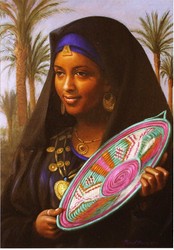 The Nubians, with their
darker skin color, Mediterranean facial features and frizzy hair to differentiate them for other Egyptians, consist of three
different groups based on their ethnic and linguistic variances.
The Kenuz who lived in the city of Aswan, speak Metouki, the
Arabs who lived 40 kilometers south of Aswan, speak Arabic, and
finally the Fedija who occupied 130 kilometers of the southern
Nile, speak Mahas The life of the Nubians
living from Aswan to the Second Cataract from the
beginning of the past century is linked to the building of the
two Aswan Dams, which caused the flooding of their traditional
environment and opened a new chapter in their history, a chapter
which we are still writing The Nubians, with their
darker skin color, Mediterranean facial features and frizzy hair to differentiate them for other Egyptians, consist of three
different groups based on their ethnic and linguistic variances.
The Kenuz who lived in the city of Aswan, speak Metouki, the
Arabs who lived 40 kilometers south of Aswan, speak Arabic, and
finally the Fedija who occupied 130 kilometers of the southern
Nile, speak Mahas The life of the Nubians
living from Aswan to the Second Cataract from the
beginning of the past century is linked to the building of the
two Aswan Dams, which caused the flooding of their traditional
environment and opened a new chapter in their history, a chapter
which we are still writing
When Egypt decided to construct the High Dam , the
World's attention was by the wonderful scheme its design ,scale
,volume ,cost and its enormous benefits to both Egypt and the
Sudan ,in addition to its political effects including the
nationalization of the maritime Suez Canal . The people of Halfa
city were moved to Khashm El- Girba ( 600km south of their
original homes ) where a new dam was built in 1964 to allow for
expansion in cultivation for the benefit of these people for
raising their level of economic prosperity. In Egypt , the
situation was different. The Egyptian Nubian had undergone three
severe cases due to the flooding of their lands . The first case
was in 1902 when the Old Aswan Reservoir was initially built.
while the second and third cases were in 1912 and 1933 when the
dam was heightened On each case the inhabitants of the flooded
area in Nubian preferred to live on the meager cultivation of
small patches of land lying at a higher level between the rocks
in their natives soil ,rather than make

a big change for the
better by emigrating. The obstinately rebuilt their houses a
little higher up and most of the men went to work in the towns
of the North in order to be able to send money home to attain
their homes families .Nubia" is the name of a specific
ethnic and culture area in Africa. It is part of the Nile
Valley, and it lies partly in southern Egypt and partly in
northern Sudan. In the north, its boundary is approximately the
area of modern Aswan, Egypt. It extends southward, along the
Nile, to about the area of modern Khartoum, Sudan, where the
Blue and White Niles meet to form the single great Nile. By the
measure of the winding river, this distance is about 1000 miles
(1600 km). In a straight line, it about 700 miles (1200 km). The
northern 200 miles (330 km) lies in Egypt; it is known as "Lower
(i.e. northern) Nubia." In the late 1960's all this land was
permanently flooded by the Aswan Dam, and the people were forced
to move elsewhere. Today the only preserved and accessible parts
of Nubia lie in northern Sudan, which is known as "Upper (i.e.
southern) Nubia." |
|
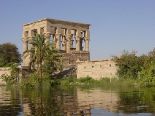 Ancient Nubia .
around 5,100 years ago, a rich
and powerful nation called the kingdom of Kush (also
referred to as the ancient Nubia) was a center of culture
and military might in Africa. Ancient Nubia had a wealth of
natural resources such as gold, ivory, copper, frankincense
and ebony but they also produced and traded a variety of
goods such as pottery
.Education in new Nuba . The literacy rate among Nubians
is very low in comparison to their rural Egyptian neighbors.
Primary , preparatory and secondary schools have been set up in
New Nubia, and there are also teacher-training facilities in the
area .The Nubians were converted to Christianity during the
sixth century. They remained so until the gradual process of
Islamization began taking place from the fourteenth until the
seventeenth centuries. Today, the Nubians are all Muslims.
However, their traditional animistic beliefs (belief that
non-living objects have spirits) are still mingled in with their
Islamic practices Ancient Nubia .
around 5,100 years ago, a rich
and powerful nation called the kingdom of Kush (also
referred to as the ancient Nubia) was a center of culture
and military might in Africa. Ancient Nubia had a wealth of
natural resources such as gold, ivory, copper, frankincense
and ebony but they also produced and traded a variety of
goods such as pottery
.Education in new Nuba . The literacy rate among Nubians
is very low in comparison to their rural Egyptian neighbors.
Primary , preparatory and secondary schools have been set up in
New Nubia, and there are also teacher-training facilities in the
area .The Nubians were converted to Christianity during the
sixth century. They remained so until the gradual process of
Islamization began taking place from the fourteenth until the
seventeenth centuries. Today, the Nubians are all Muslims.
However, their traditional animistic beliefs (belief that
non-living objects have spirits) are still mingled in with their
Islamic practices |
|
|
|
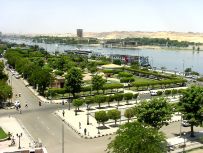 Aswan (ancient Syene),
city in southern Egypt, capital of Aswan Governorate, on the
Nile River, near Lake Nasser. Under the pharaohs, Syene was an
important city near quarries that furnished the granite for many
Egyptian temples. The period of greatest prosperity, however,
was under the Romans. Modern Aswan contains many ancient
architectural remains. The city's industries use
hydroelectricity produced at the nearby Aswan High Dam. The
Higher Industrial Institute (1962) is in Aswan Aswan (ancient Syene),
city in southern Egypt, capital of Aswan Governorate, on the
Nile River, near Lake Nasser. Under the pharaohs, Syene was an
important city near quarries that furnished the granite for many
Egyptian temples. The period of greatest prosperity, however,
was under the Romans. Modern Aswan contains many ancient
architectural remains. The city's industries use
hydroelectricity produced at the nearby Aswan High Dam. The
Higher Industrial Institute (1962) is in Aswan
Aswan is the southern-most city in Egypt. It has a
scenic location on the eastern banks of the Nile. Looking across
the Nile to the west bank, one can see the desert descend the
hillsides to the greenery that hugs the banks of the river.
Several islands are sprinkled along the Nile here and rock
outcroppings add to the beauty of the surrounding scenery. The
fall and winter climate is ideal when near the river - warm,
with slight breezes that propel feluccas up and down and across
the Nile. The population here is largely Nubian, a distinctly
different flavor from Egyptian, more African seemingly |
|
|
|
 In the new
Nubia
, the three group are resettled in three separate
areas to ensure the independence of each one. The
facades were mostly plastered , painted and decorated .
Mastabas ( the low clay benches along the front of the
houses ) were often built to serve their traditional
function as outdoor places for neighborhood gatherings
and entertainment individual and combined barns were
also built to keep animals out of the houses in order to
maintain cleanliness of the living quarters. The climate
of the new settlement area much resembles that of Nubia
. The land is ample and all village are near their own
fields. In general the whole project was based on
principle of justice and self-sufficiency . Full
attention was to the Nubian's spiritual as well as
physical welfare.In the past, Nubian life
revolves around the Nile River. The
Nile provides water for drinking, cooking, and washing as well
as for irrigation. The yearly flood makes agriculture possible.
In the midst of the desert, the flood not only brings abundant
water but also renews the soil along its banks by depositing a
rich load of silt from upstream. In appreciation for the
benefits of the Nile, the entire village gathers by the river
during ceremonies such as weddings, circumcisions, and harvest
festivals.Nubian life revolves
around the Nile River. The Nile provides water for drinking,
washing, agriculture, In appreciation for the benefits of the
Nile. the entire village gathers by the river during ceremonies
such as birth, weddings , circumcisions, and harvest festivals In the new
Nubia
, the three group are resettled in three separate
areas to ensure the independence of each one. The
facades were mostly plastered , painted and decorated .
Mastabas ( the low clay benches along the front of the
houses ) were often built to serve their traditional
function as outdoor places for neighborhood gatherings
and entertainment individual and combined barns were
also built to keep animals out of the houses in order to
maintain cleanliness of the living quarters. The climate
of the new settlement area much resembles that of Nubia
. The land is ample and all village are near their own
fields. In general the whole project was based on
principle of justice and self-sufficiency . Full
attention was to the Nubian's spiritual as well as
physical welfare.In the past, Nubian life
revolves around the Nile River. The
Nile provides water for drinking, cooking, and washing as well
as for irrigation. The yearly flood makes agriculture possible.
In the midst of the desert, the flood not only brings abundant
water but also renews the soil along its banks by depositing a
rich load of silt from upstream. In appreciation for the
benefits of the Nile, the entire village gathers by the river
during ceremonies such as weddings, circumcisions, and harvest
festivals.Nubian life revolves
around the Nile River. The Nile provides water for drinking,
washing, agriculture, In appreciation for the benefits of the
Nile. the entire village gathers by the river during ceremonies
such as birth, weddings , circumcisions, and harvest festivals |
|
|
|
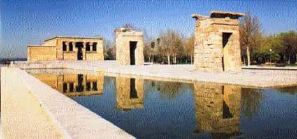 The History of Nubian
civilization extends back to abouit 17,000 years (See Van
Sertima: Egypt Revisited) { Pianke Nubiyang in THE RISE OF
NUBIANISM } The History of Nubian
civilization extends back to abouit 17,000 years (See Van
Sertima: Egypt Revisited) { Pianke Nubiyang in THE RISE OF
NUBIANISM }
The Nubians created the world's first civilization and that
civilization was much older than Egypt. In fact, in 2000,
archeologists discovered many facinating artefacts, including
glasswork of great beauty and excellent craftsmanship. These
were found in Sudan and according to Time Magazine, some
artefacts were dated to about 8000 years B.C. Astronomy was also
well organized in Nubia during the period and an astronomical
observatory dating back to about 7000 B.C. was found in Sudan as
well. It is also in Sudan that a large number of ancient cities
exist
The Nubians also built a large number of small pyramids later on
in their history but they used a very sophisticated system of
tombs to bury their kings. Many were similar in style to the
early Egyptian Mastabas. Those of later centuries were small
pyramids with chapels built on top and the tombs at the beneath
the ground
Still, the Nubians continue to maintain their pride and their
culture. They continue to maintain their history and to make
sure that their contributions to world civilizations is not
stolen. During a conversation with Nubians, Professor Gates (who
made a documentary on African history about two years ago) found
out first hand that Nubians in Nubia continue to maintain the
great pride in self that was part of the spiritual consciousness
that made Nubian civilization great and long-lasting
. Although today
we speak of "ancient Nubia," the name "Nubia" did not exist
before the Middle Ages. The term seems originally to have come
from the tribal name "Nuba" or "Noba", which first appears in
historical texts in the second century BC. By the fourth century
AD, they were dwelling on both sides of the river and had
absorbed the declining kingdom of Kush, centered at Mero‘. They
were converted to Christianity in the sixth century AD and
formed first three, then two, Christian kingdoms that flourished
side by side until the fifteenth century. These people gave
their name to these kingdoms, which were called "Nubian |
|
|
|
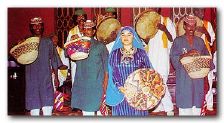 Many early Egyptian
inscriptions, dating between 3200
and 2600 BCE, mention Nubia, which is called "Land of the Bow."
At least five of these seem to be about Egyptian military raids
on Nubia. Because hieroglyphic writing of this time does not
give us detailed history, we know little of these eventsNubia
was famous throughout ancient history as a land of expert and
feared archers. Pictures from as early as 3200 BCE show Nubians
carrying bows. The Egyptians even used a bow as the hieroglyphic
spelling for the name "Nubia." Throughout history, pictures and
drawings of Nubian gods, kings, and warriors show them holding
bows. In graves of Nubian men, archaeologists often find their
skeletons holding bows and lying beside quivers of arrows. In
later centuries, men were sometimes buried wearing stone rings
on their thumbs. These rings allowed them to pull back the
bowstrings without cutting or hurting themselves.About 2600 BCE,
the Egyptians began hiring thousands of Nubian men as archers
for their armies .Ancient Nubia is one of
the richest areas of Egypt in terms of ancient monuments.
Nubia contains 16 temples, amongst the most important of which
is the Great Temple of Abu Simbel, 280 kilometres south of
Aswan. This temple was carved from the rock in the reign of
Rameses II on a rocky hill overlooking the Nile. Four statues of
the Pharoah carved from the living rock guard the temple. Nearby
is the Lesser Temple of Abu Simbel, dedicated by Rameses II to
the goddess Hathor, and also carved from the rock in honor of
his wife Nefertari Many early Egyptian
inscriptions, dating between 3200
and 2600 BCE, mention Nubia, which is called "Land of the Bow."
At least five of these seem to be about Egyptian military raids
on Nubia. Because hieroglyphic writing of this time does not
give us detailed history, we know little of these eventsNubia
was famous throughout ancient history as a land of expert and
feared archers. Pictures from as early as 3200 BCE show Nubians
carrying bows. The Egyptians even used a bow as the hieroglyphic
spelling for the name "Nubia." Throughout history, pictures and
drawings of Nubian gods, kings, and warriors show them holding
bows. In graves of Nubian men, archaeologists often find their
skeletons holding bows and lying beside quivers of arrows. In
later centuries, men were sometimes buried wearing stone rings
on their thumbs. These rings allowed them to pull back the
bowstrings without cutting or hurting themselves.About 2600 BCE,
the Egyptians began hiring thousands of Nubian men as archers
for their armies .Ancient Nubia is one of
the richest areas of Egypt in terms of ancient monuments.
Nubia contains 16 temples, amongst the most important of which
is the Great Temple of Abu Simbel, 280 kilometres south of
Aswan. This temple was carved from the rock in the reign of
Rameses II on a rocky hill overlooking the Nile. Four statues of
the Pharoah carved from the living rock guard the temple. Nearby
is the Lesser Temple of Abu Simbel, dedicated by Rameses II to
the goddess Hathor, and also carved from the rock in honor of
his wife Nefertari
By the time the High Dam was completed in 1971 and the
whole of Nubia was flooded by Lake Nasser, the great temples of
the area had been saved. Some had even been transported, piece
by piece, to countries like the United States and Sudan. The
magnificent temples of Abu Simbel, Kalabsha, Philae, El-Sebua,
Amada, Beit El-Wali, and the Kiosk of Kertassi |
|
|
|
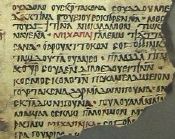 The Nubian can
be proud of their language and should be reminded
of the old Nubian, the language of the medieval
Christian kingdom, is the only African non-Afro-Asiatic
language which developed a literature written for at
least 700 years,i.e. from the 16th to 15th A.D. The
study of old nubian and the publication of the texts
discovered in different campaign's is still going on
Language: The Kenuzi speak Kenuzi-Dongolawi while the
Fedidja speak Fedidja-Mahas. There is also a group within
the Nubians who have become Arabicized to the point that
their first language is now Arabic. Most of
the men today are bilingual, speaking their
Nubian language and Arabi .The
Nubian languages make much more use of suffixes than of
prefixes or infixes, especially in noun inflection. Nouns
have forms for the nominative, vocative, objective,
genitive, locative, in strumental, and ablative cases in
some of the languages. A collective noun used as the subject
of a sentence may be followed by either a singular or a
plural verb
.About fifty languages spoken in the Nuba Mountains
(I am of course talking about the situation that persisted
at least until the late 70s) we classify them into members
of two or perhaps three language families - Nilo-Saharan and
Kordofanian (sub-family of the Niger-Kordofanian family). Of
course in addition there is Arabic which could not have been
spoken in the area prior to the Muslim invasions of Egypt in
the 700s (Common Era) or the first century AH and there are
also speakers of Fulani and some other West African
languages. All the other languages of the Mountains well
predate that period and in most cases were spoken there from
time immemorial. The Kordofanian languages consist of four
groups: Heiban, Talodi, Rashad and Katla - these names are
based on their geographical centres (proposed by Thilo
Schadeberg) and differ from names used in previous
literature. The Kadugli Group was earlier classified by
Greenberg as part of Kordofanian but removedfrom that
relationship by Schadeberg and is currently considered
probably part of Nilo-Saharan. The Kordofanian sub-groups
are located in the southern and eastern areas of the Nuba
Mountains. The Kadugli Group is located in the south east
central fringe area near Kadugli The Nubian can
be proud of their language and should be reminded
of the old Nubian, the language of the medieval
Christian kingdom, is the only African non-Afro-Asiatic
language which developed a literature written for at
least 700 years,i.e. from the 16th to 15th A.D. The
study of old nubian and the publication of the texts
discovered in different campaign's is still going on
Language: The Kenuzi speak Kenuzi-Dongolawi while the
Fedidja speak Fedidja-Mahas. There is also a group within
the Nubians who have become Arabicized to the point that
their first language is now Arabic. Most of
the men today are bilingual, speaking their
Nubian language and Arabi .The
Nubian languages make much more use of suffixes than of
prefixes or infixes, especially in noun inflection. Nouns
have forms for the nominative, vocative, objective,
genitive, locative, in strumental, and ablative cases in
some of the languages. A collective noun used as the subject
of a sentence may be followed by either a singular or a
plural verb
.About fifty languages spoken in the Nuba Mountains
(I am of course talking about the situation that persisted
at least until the late 70s) we classify them into members
of two or perhaps three language families - Nilo-Saharan and
Kordofanian (sub-family of the Niger-Kordofanian family). Of
course in addition there is Arabic which could not have been
spoken in the area prior to the Muslim invasions of Egypt in
the 700s (Common Era) or the first century AH and there are
also speakers of Fulani and some other West African
languages. All the other languages of the Mountains well
predate that period and in most cases were spoken there from
time immemorial. The Kordofanian languages consist of four
groups: Heiban, Talodi, Rashad and Katla - these names are
based on their geographical centres (proposed by Thilo
Schadeberg) and differ from names used in previous
literature. The Kadugli Group was earlier classified by
Greenberg as part of Kordofanian but removedfrom that
relationship by Schadeberg and is currently considered
probably part of Nilo-Saharan. The Kordofanian sub-groups
are located in the southern and eastern areas of the Nuba
Mountains. The Kadugli Group is located in the south east
central fringe area near Kadugli
|
|
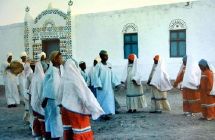 At the time of their
relocation in 1963, the Nubians consisted of nearly
120,000 people, 29% of Egypt's total population. They took great
pride in the simple pleasures of music, dance, work and their
homes. Like similar tribes of people across the world, they were
connected to their homelands and took tremendous satisfaction in
the lands of Nubia, in which they had made their havens At the time of their
relocation in 1963, the Nubians consisted of nearly
120,000 people, 29% of Egypt's total population. They took great
pride in the simple pleasures of music, dance, work and their
homes. Like similar tribes of people across the world, they were
connected to their homelands and took tremendous satisfaction in
the lands of Nubia, in which they had made their havens
In the mid-1950’s, Nubian concerns increased as rumors began
telling of a construction of a "new high dam" that would further
flood Nubian homelands. The result would be a large-scale move
further inland as their homelands were soon to be inundated by
water. Feelings of hopelessness, grief and depression overtook
the Nubian people, but with no other choice available, they were
forced to leave. Those who were effected the most adversely were
the older generations who had gained a real sense of hearth in
their birthplace of Nubia
On October 18, 1963 the first displacement of people occurred.
501 families, consisting of 1,233 people, their livestock and
belongings were evacuated from the Kenuz village of Daboud,
which was 25 kilometers south of Aswan. It was reported to be a
traumatic experience for them as many kissed the ground and
filled their pockets with soil . Several groups of Nubians consisting of approximately 100,000
people were eventually displaced. Lack of planning, and sheer
size of the displaced people caused numerous logistical
problems. For instance, at the time that many were relocated the
homes that they were promised were not yet complete. Several
families had to share a single home while houses were being
constructed. Also, a good number of the livestock that many
relied on as food sources did not survive the journey.
Therefore, the availability of food was a great concern for a
while. The Nubians re-decorated their surroundings to become
more familiar and to feign an assemblance of what they had left
behind. This was against the regulations of the new area, but
the government conceded to their request .The governments position stated that the displacement of the
Nubian people was a small price to pay when weighed against
the benefits that were to be provided by the new Aswan High
Dam. By allowing the Russians, whose main concern was only
with the mechanics of the dam, to control the project, the
Egyptian government allowed itself to rush into a planned
design without adequate research into the possible impacts
of such a design, nor did they identify the logistical
processes required to manage such a large-scale movement of
people. This lack of planning and organization paid a grave
disservice to a large portion of its population: (The Nubian
people |
|
|
|
e-mail
/shazlyesmail@gmail.com |
|
|
|